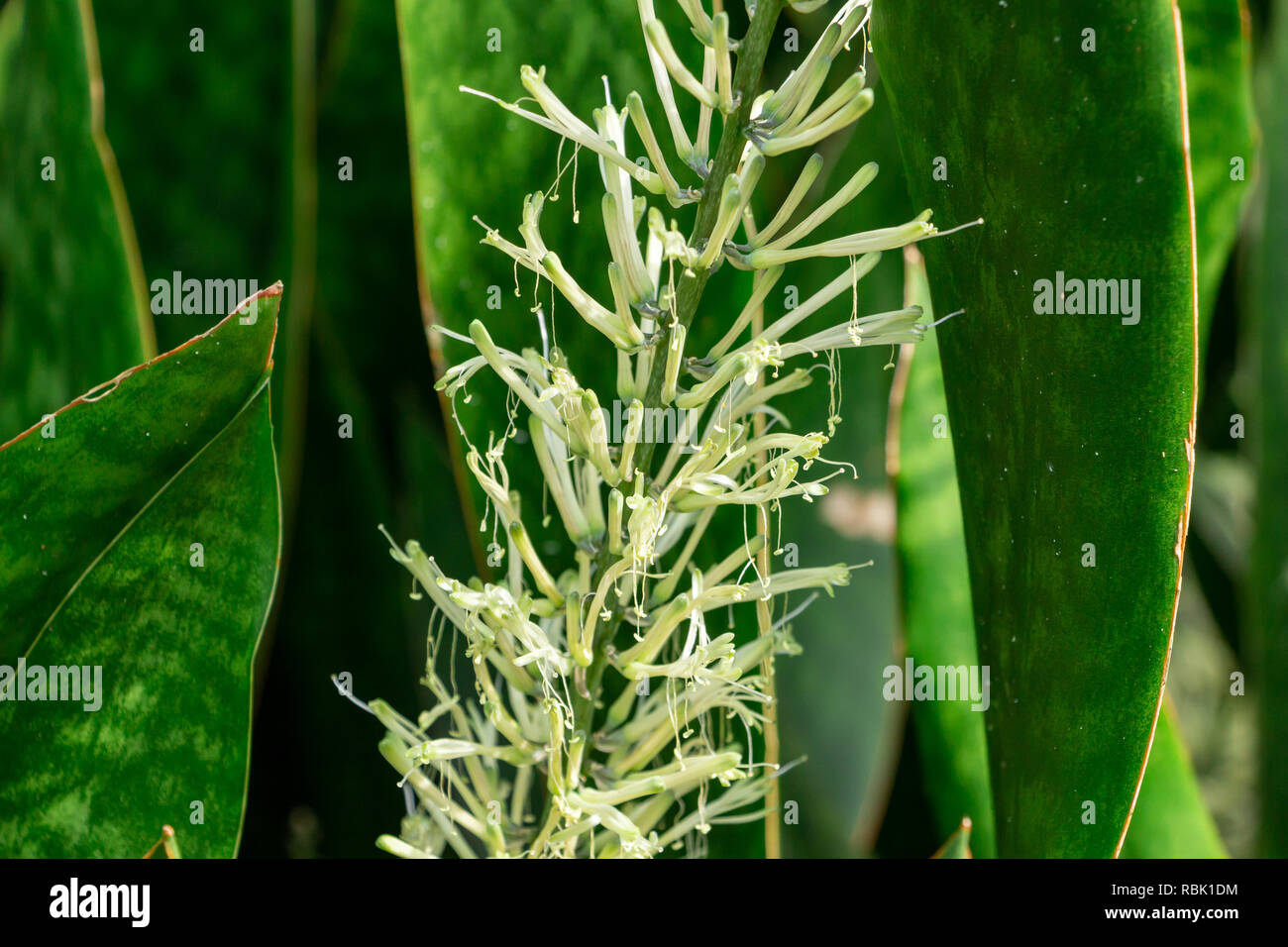The mother-in-law’s tongue plant, also known as the snake plant or Sansevieria, is a popular houseplant known for its striking leaves and hardy nature. What many don’t know is that this plant can occasionally produce delicate flowers on tall stalks, treating its owner to a spectacular floral display.
Do Mother-In-Law’s Tongue Plants Flower?
While rare mother-in-law’s tongue plants can and do flower. Out of the 70 species in the Sansevieria genus most can produce flowers, with a few exceptions like the bird’s nest Sansevieria.
Don’t be surprised if you’ve owned one of these plants for years without any sign of flowers Blooms tend to appear randomly and may only occur once every few decades When they do emerge, it’s a special occasion.
What Do the Flowers Look Like?
The flowers of mother-in-law’s tongue plants arise on tall, erect stalks reaching up to 3 feet in height. Clusters of dozens of tiny, tubular blossoms develop along the length of these stalks, resembling lily or honeysuckle flowers.
Some species produce flowers right from the base rather than on a stalk. The slim petals come in white, green, yellow, or reddish hues, depending on variety. They make a stunning statement when they appear amongst the striking spiky leaves.
When Does Flowering Occur?
If your mother-in-law’s tongue plant produces blooms, it will likely only flower once a year at most, typically in the spring. The blossoms last a few weeks before dying back. In some cases, orange berries then develop where the flowers once were.
While flowering is unpredictable, when conditions are right, you may be treated to flowers each spring. But there’s no guarantee your plant will ever bloom.
Why Do These Plants Flower?
What triggers flowering in the snake plant is not fully understood. However, there are a few factors believed to help
-
Age – Older, mature plants are more likely to bloom than younger ones.
-
Root bound conditions – Becoming pot bound can stress the plant and shift energy toward flowering.
-
Light – Bright light provides energy needed for blooming.
-
Low water – Mild drought stress may encourage flowers.
-
High phosphorus fertilizer – Phosphorus boosts blooming.
So a combination of maturity, adequate sunlight, mild neglect, and a touch of fertilizer may coax out the elusive blooms. But sadly, there is no sure way to make these plants flower.
Fragrance and Other Details
The flowers produce a powerful, sweet fragrance that perfumes the whole room when they emerge. Their nectar frequently attracts pests though.
Rest assured, the plant won’t die after flowering. And you can cut off spent flower stalks to keep it looking tidy.
For most snake plant owners, encountering the delicate flowers is a rare surprise. But if your plant is mature and cared for properly, with a bit of neglect at times, you may just get to experience these unique blooms. If you do, enjoy their fleeting beauty while it lasts!

Wildlife – Snake Plant Attracts the Following Friendly Pollinators
The Mother-in-laws Snake plant is a popular houseplant that is known to attract friendly pollinators such as bees, hummingbirds, and butterflies. These pollinators are drawn to the plants unique flowers, which emit a sweet scent and provide a source of nectar. By welcoming these beneficial insects into your home or garden, you can help support local ecosystems and promote biodiversity.






According to ASPCA, the mother-in-law plant is mildly toxic if ingested, primarily due to the presence of saponins. These compounds can cause gastrointestinal distress in both humans and animals, with symptoms like nausea, vomiting, and diarrhea. However, it is safe to touch and handle, making it a popular choice for indoor plants in homes with pets or children.
Hardiness Zones & More

In the United States, this is mostly an indoor plant, but if you live in southern Florida or Hawaii, then you can cultivate it outdoors in USDA zones 9-11.
In colder zones, the succulent plant Snake Sansevieria can still be grown, but it will need to be grown indoors or in a greenhouse during the winter months to protect it from freezing temperatures.
While household humidity is generally good enough, these large snake plants will do even better with some extra moisture in the air. Please set up a humidifier nearby or grow them in naturally humid rooms like your bathroom or kitchen.
How To Care For A Snake Plant | Mother In Laws Tongue Plant Care
FAQ
How often does Mother-in-law’s tongue flower?
While not a typical flowering plant, small, white flowers may grow at the base of a plant after a few years. Years may pass between flowering, so enjoy it when it does.
How do you take care of mother in law tongue flowers?
- Only water occasionally. …
- Find a home with medium light. …
- Repot in well draining soil. …
- Mild temperatures are its favourite. …
- Don’t worry about humidity. …
- Keep an eye out for pests. …
- Sansevieria trifasciata. …
- Sansevieria hahnii (or Bird’s nest snake plant)
What does it mean if your snake plant blooms?
An indoor snake plant that blooms is likely doing so because some neglect made it stressed. Plants bloom to ensure their survival. Blooms, when pollinated, produce fruits and seeds which translate to potential new plants. If grown indoors it’s unlikely to produce berries to complete the life cycle.
What are the benefits of mother in law’s tongue flower?
- Releases Oxygen at Night. …
- Purifies The Air & Removes Pollutants. …
- Helps Fight Allergies. …
- Low Maintenance Plant. …
- Sleep Inducing & Stress Relieving Properties. …
- Plant Symbolism & Feng-Shui. …
- MILT Sansevieria Plant Care.
